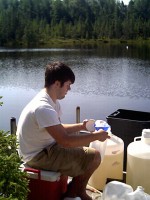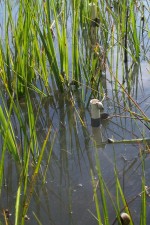Gary Toranzos and Mathew Kane of NSF, John Vande Castle of LTER Network Office and the principal investigators of the LTER Microbial Observatories
When the first six LTER sites in the LTER Network were funded in 1980, the idea of studying specific ecosystems at temporal and spatial scales was revolutionary. Currently all 24 LTER sites participate in this endeavor, and there is much interest from LTER networks forming in Latin America, Africa, Europe, Australia, and Asia to develop this work further, demonstrating the importance of multiple-scale science initiatives.
Among all existing organisms, prokaryotes are the most numerous and the most ubiquitous, but ironically, the least understood. Their roles in biological processes is virtually unknown. With this in mind, NSF initiated “The Microbial Observatories Program.” The guiding themes of the MO Program (http://www.nsf.gov/pubs/2002/nsf02118/nsf02118.htm) are: the discovery of newly described or poorly understood microorganisms/consortia/communities from diverse habitats, but not simply their discovery—also the exploration of these organisms and their unique genomic, metabolic, ecological and/or evolutionary properties at a particular site or habitat.
In response to this initiative, LTER formed a Subcommittee on Microbial Ecology and drafted a tentative research agenda for LTER-associated MO projects in 1999 (See http://www.lternet.edu/microbial_ecology). Three years later, it is encouraging to see that eight of the thirty NSF funded Microbial Observatories have been established at LTER sites. LTER sites are “user-friendly” for microbiologists, as data for any Microbial Observatory project can be coordinated with and compared to other data that gathered by LTER participants.
We now know that prokaryotes are the most abundant and ecologically and metabolically diverse forms of life on Earth. Genomic segments have been transferred across the broadest of phylogenetic boundaries, implying that close to its roots, the Tree of Life has more web-like than branch-like connections. The concern over bio-terrorism makes research in microbial ecology very timely. As more robust and sensitive methods are developed to scrutinize prokaryotic biota, we will be better able to understand microbial processes. In this manner within the realm of ecology, microbial processes will no longer be in a “black box.”
The National Science Foundation hosted a workshop for researchers of all the Microbial Observatories 22-24 Sept 2002. Results from the workshop and links to all the LTER Microbial Observatory Projects listed here can be found at: http://www.lternet.edu/microbial_ecology
Salt Marsh Microbes and Microbial Processes: Sulfur and Nitrogen (Plum Island LTER) John Hobbie
Microbial Observatory research at the Plum Island LTER site identifies prokaryotes in salt marsh sediments and plankton and determines their role in controlling major ecosystem processes. They have found that organic materials, probably of algal origin, dominate both sediment organic-carbon composition and bacterial carbon processing in the Spartina marsh. The diversity of ammonia oxidizing bacteria suggest that salinity is a primary factor in driving community structure, and possibly metabolic function, of these organisms in estuarine sediments. Annual patterns of sulfate reducing bacteria diversity in the rhizosphere show persistent populations throughout the growing season while greater variability was seen in unvegetated creek sediments. Mixing of marine and freshwater communities along the salinity gradients result in a third community unique to estuarine waters, which is related to the flushing time of the estuary and to the high productivity of phytoplankton blooms.
A Microbial Observatory for the Northern Temperate Lakes LTER Eric Triplett
The research objective at North Temperate Lakes LTER is to characterize the diversity of freshwater microbial populations and their relationship to ecosystem processes in lakes that represent the major trophic types of temperate landscapes: oligotrophic (clear water, few nutrients), humic (brown water, rich in dissolved organic carbon), and eutrophic (nutrient rich, high biomass of algae and bacteria). Their reserach combines molecular methods for describing naturally occurring microbial communities with more traditional measures of microbial processes and microscopic assessments of algal and bacterial populations. During the ice-free period for two successive years, our data reveal that while bacterial community composition within a particular lake can exhibit rapid changes, the greatest variability in BCC was observed between lakes.
Prokaryotic Diversity of a Salt Marsh/Estuarine Complex at the University of Georgia Marine Institute, Sapelo Island (Georgia Coastal Ecosystems LTER) Mary Ann Moran
Our efforts focus on the composition and functioning of microbial communities in coastal salt marshes in the southeastern U.S. Research on decomposer communities has uncovered a diverse bacterial community that is physically associated with a low-diversity acomycete-dominated fungal community. These communities vary with season and decomposition stage, but show little spatial heterogeneity in the marsh ecosystem. Gene sequencing approaches to describing microbial communities have revealed considerable ‘microdiversity’ within salt marsh bacterial taxa; the ecological importance of this 16S rRNA microdiversity is not yet well understood, but may be a critical issue for linking microbial structure and function. Sequence data from these and other molecular ecology studies need to be integrated with ecological information about samples, collection conditions, and environmental characteristics. We have constructed a prototype web-accessible public database that links 16S rRNA gene sequences with associated environmental information (http://www.simo.marsci.uga.edu).
Diversity of Nitrogen-Cycling Microorganisms at the H.J. Andrews LTER David Myrold
Investigators at the H.J. Andrews hope to determine links between vegetation types and microbial communities, to examine the spatial variability along meadow-to-forest transects, to correlate microbial community structure with nitrogen cycling processes, and identify key and potentially novel nitrifying and denitrifying bacteria. Findings indicate that nitrification potentials are consistent along meadow-to-forest transects and only changed significantly after crossing a boundary. Nitrification and denitrification potentials are more than ten-fold higher in the meadow than forest soil, consistent with past studies. Similar shifts are observed in microbial community composition.
Observing Patterns of Prokaryotic Diversity along Land use Gradients of the CAP Fred Rainey
The Central Arizona-Phoenix Long Term Ecological Research (CAP LTER) site is investigating changes in bacterial diversity across land use gradients and the ubiquity of certain bacterial groups throughout the compact yet diverse environment. We have found a significant difference in the proportion organisms between urban and desert samples. Using culture-independent tools we have seen distinct shifts of bacterial diversity dependent on land use as well as the discovery of taxa that have the abilities to remain throughout the site.
Spatial Scales of Genetic and Phenotypic Diversity Among Streptomycetes in Native Soils (takes place at Cedar Creek LTER) Linda Kinkel
The main objectives for this research is to spatially quantify genetic and phenotypic diversity among the antibiotic-producing microorganisms Streptomycetes. The research also looks at the effects of different plant species on microbial genetic diversity. We know that at CDR, genetically similar organisms tend to be tightly clustered in space and there is a very high diversity of antibiotic activities among Streptomycetes in at all spatial scales. Studies of the resulting antibiotic inhibition and resistance show the inhibition effects increase with soil depth and that organisms were better at inhibiting isolates originating from different locations than from the same location in soil, and the associations of Streptomycetes vary significantly with different plant species.
Microbial Biogeochemistry and Functional Diversity across the Forest-Tundra Ecotone in the Rocky Mountains (Niwot Ridge LTER) Steve Schmidt
Microbial studies near Niwot Ridge focus on changes in microbial biogeochemistry and diversity associated with the transition from the snow covered winter period to summer growing season in alpine tundra and sub-alpine forests of the Rocky Mountains. The comprehensive seasonal approach has provides new insight into both microbial diversity and biogeochemical functioning in the highly seasonal environment. They have found a large temporal variation in microbial activity, with pronounced biogeochemical changes evident during snowmelt. The research in general implies that soil microbial communities are very dynamic at any given site.
A Cold Microbial Observatory: Collaborative Research in an Alaskan Boreal Forest Soil (Bonanza Creek LTER) Jo Handelsman
A particular interest at Bonanza Creek is the role of microorganisms in the phosphorus cycle and the limitation of phosphorus on ecosystem productivity. The goals are to describe the diversity of the microbial life in the soil and discover mechanisms by which microbes in the soil extract phosphorus from the environment. Preliminary analyses suggest that there is potential for discovering novel bacterial groups and mechanisms of utilization of phosphorus.

 Enlarge this image
Enlarge this image

